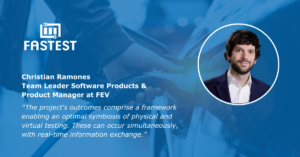
The project’s outcomes comprise a framework enabling an optimal symbiosis of physical and virtual testing. These can occur simultaneously, with real-time information exchange.
Christian Ramones is Team Leader for Software Products & Product Manager at FEV, one of our consortium partners. They are responsible for shaping the software architecture that facilitates communication and data management among the digital twin, battery test centers, and the cloud-based co-simulation platform. Additionally, they provide the latter platform.
1. How will the FASTEST Project impact the battery industry?
With the current surge in Battery Electric Vehicles (BEVs) and their variants, the forecast predicts a substantial 24% increase in battery testing by 2027 compared to 2022. Given that the FASTEST Project concludes in mid-2026, its results will be available during this peak growth period.
The project’s outcomes comprise a framework enabling an optimal symbiosis of physical and virtual testing. These can occur simultaneously, with real-time information exchange. For instance, we can combine simulated thermal cycling tests with physical mechanical resistance tests or update model parameters within the digital twin during ongoing physical tests. This then will allow to split tests in test sessions: the initial sessions will be done on the physical test bench, and after model validation the subsequent tests can be simulated. This allocation will happen automatically and in real-time.
The resulting benefits are straightforward: a significant reduction in overall physical testing time leading to higher battery test bench utilization and an overall reduction in electrical power usage, as we can minimize physical charging.
2. Which existing bench technologies may be employed for the FASTEST project, and to what extent will new hardware or software need development?
A cornerstone of the project is establishing real-time communication between battery test centers, their test benches, the digital twin, and the cloud co-simulation platform. To achieve this, we’ll implement a cloud-based software architecture utilizing reliable communication technologies from the proven Internet of Things (IoT) sector.
I am genuinely excited to witness this framework in action. By leveraging cutting-edge cloud infrastructure technologies, the project aims to set a new standard for battery testing. We are integrating the latest advancements in both battery testing and simulation models to push the boundaries in this field.
